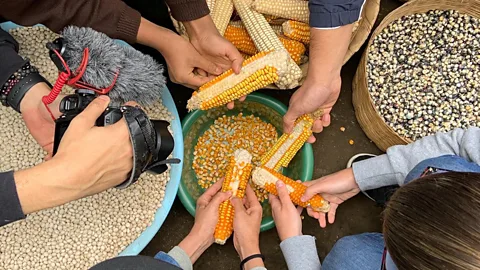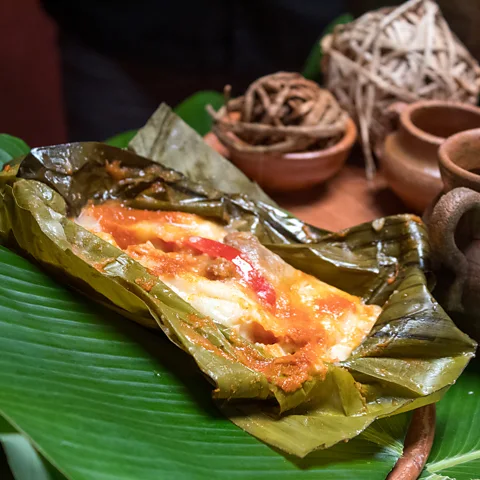The large and fluffy tamale few know
 Hugo Espinoza
Hugo EspinozaAn icon in its native land, the Guatemalan tamale is wrapped in a striking green banana leaf that gives way to an airy corn dumpling stuffed with spicy pork, peppers and olives.
Deep inside a 6th Century Mayan pyramid in Guatemala's Petén region, archaeologist Francisco Estrada-Belli stumbled on a massive carved frieze; a mythological scene. A Mayan king in apotheosis is flanked by two ancestor gods, each holding out a round-shaped offering. The glyph beneath reads: The first tamale.
"This was the biggest discovery of my life," said Estrada-Belli of the 2013 find. "It's very powerful symbolism that tells you how fundamental the tamale was regarded by the Maya."
In the English-speaking world, the word "tamale" is invariably associated with delicious Mexican husk-wrapped cornmeal dumplings. But tamales may actually be ancestral to Guatemala, Mexico's Southern neighbour and a crucial Mayan centre.
"We see images of tamales [in Guatemala] before the time of Christ," said Estrada-Belli. For instance, the San Bartolo mural discovered in Guatemala's Ixcan River Basin in 2001, depicts a maize ceremony and a woman holding three corn balls: tamales. "It's from 50 BC. There are no murals as early as this one in Mexico or anywhere else."
Not only does archaeological evidence point to Guatemala as the birthplace of tamales, but their depictions in Guatemalan Mayan art and ancient texts like the Dresden Codex (a 12th Century Mayan book) and the Florentine Codex, a 16th Century anthropological study of the Mesoamerican peoples, show that they evolved from naked balls of cornmeal called wa'aj.
 Holmul Archaeological Project
Holmul Archaeological Project"[Wa'aj means] 'sacred food of the gods', said archaeogastronomist Regina Moraga. "There's no evidence that they were wrapped in leaves." It wasn't until after the arrival of Columbus – and influx of new ingredients – that the cornmeal balls took their iconic leaf-swaddled form. "The name comes from the Nahuatl (Aztec language) tamali," explained Moraga."Wrapped".
Today, hundreds of leaf-wrapped tamale varieties exist throughout Mesoamerica; the region of Central America spanning from Mexico to Honduras. So why is the Mexican tamale the only version known outside of Latin America? "Mexico is such a big country," explained chef Debora Fadul, owner of Guatemala City's award-winning plantation-to-table restaurant, Diacá. "Their cuisine is way more famous than the other Latin American countries."
But chef Mirciny Moliviatis, a Guatemalan culinary TV show host who's spent 15 years researching Guatemala's gastronomic culture, said: "I can assure you that Guatemala is the heart of the tamale-making world. We have the history and the recipes."
 Debora Fadul
Debora FadulThere are over 240 tamale varieties in Guatemala alone, including the pache, a tamale made with potatoes, the chocolatey tamal negro, and the boxbol, a squash tamale wrapped in chayote leaves. With so many variations, tamales are tricky to define. "It's something wrapped in a leaf," said Moliviatis. "Usually maize or starch."
The tamale legacy
In December 2022, Moraga and a panel including archaeologists, ancestral cooks, anthropologists andChef Alex Quintana of Guatemala City's Quintana Bistro launched a petition to the National Congress of Guatemala to register the tamale as intangible cultural heritage. "The tamale has been eaten in Guatemala for thousands of years longer than the tortilla," said Quintana. "Our hope is that if the petition passes, we can take it to Unesco."
And beyond question, the tamale most tied to Guatemalan identity is the brightly-coloured tamal colorado, made with cornmeal, bell peppers, tomato-based recado (gravy), olives, capers and meat, all wrapped in dramatic green plantain leaves. Its preparation can take up to two days due to the nixtamalization, in which the corn is boiled in lime or ash, allowed to rest and cool, then milled before it's cooked with salt and pork fat; resulting in a fluffy masa (dough) that melts deliciously in the mouth. "They have more water than Mexican tamales," explained Chef Fadul. "That's why they're softer."
The tamal colorado isn't just colourful and delicious: archaeologists believe it is the direct descendant of the balls of masa depicted in Classic period Mayan art (250-900BCE).
 Debora Fadul
Debora Fadul"In the San Bartolo mural they look like pastries, an oval shape," said Estrada-Belli. "Presumably corn made with the process of nixtamalization, which the Mesoamerican people invented long before the Classic period. [The balls are covered in] a paste with red sauce; presumably tomatoes and chili. They look very much like the tamales that you buy now on the street."
So the tamal colorado is a Mayan recipe? "No," said Moraga. "It has a pre-Hispanic cultural tradition, but also a European one." Europeans brought capers, olives and chicken to Mesoamerica during the conquest. "They introduced pork fat. The Spaniards brought cinnamon, pepper, sesame… everything that goes into the recado today… and the African slaves brought banana leaves. It's a traditional Guatemalan dish with Mayan roots."
 Hugo Espinoza
Hugo EspinozaAnd still very sacred to today's Guatemalans, who eat tamales year-round, most often at celebrations like weddings, baptisms, birthdays, Christmas and even funerals. When they're served, the binding fibers are snipped open with a knife; the slick leaves part to reveal the treasure inside.
"It's a dish that expresses a bite full of culture," said Moliviatis. "It was ceremony to go to my grandmother's house on Saturday to make tamales from six in the morning to five in the afternoon." Moliviatis's memories of making tamales are precious yet familiar to so many Guatemalans. Fadul recalled her family gatherings to assemble tamales: "It was a big line… every aunt and cousin… Like, I will put the masa, you will put the peppers, you will put the olives, you will put the chicken, you will wrap it… everybody had a job." Moraga added, "No two cooks' tamales are ever the same."
 Hugo Espinoza
Hugo EspinozaServes 4
Ingredients
For the recado (gravy):
680g (1½lb) ripe tomatoes
2 red bell peppers
1 Guatemalan chilli guaque (or dried red pepper)
1 Guatemalan chilli pasa (or other smoky dried pepper)
57g (2oz) sesame seeds
57g (2oz) pumpkin seeds
1 small cinnamon stick
2 cloves
28g (1oz) allspice
28g (1oz) pork lard
achiote paste to taste (or powder)
salt to taste
For the dough:
½ cup rice flour
454g (1lb) instant corn flour like Maseca
680g (1½lb) lard (or 1 stick of butter + ½ cup of vegetable oil as a substitute)
4 tbsp salt
For the leaves and toppings:
3 red bell peppers
10 plantain leaves
5 maxán leaves or sheets of pergamin paper (baking or parchment paper)
1 bunch of cibaque fibers, soaked and softened for tying the tamales (or use cooking twine)
900g (2lb) pork or chicken in pieces
113g (4oz) pitted olives
113g (4oz) capers
lemon wedges, for serving
Method
Step 1
To make the recado, add a small quantity of water to a large saucepan and bring to a simmer. Add the tomatoes, bell peppers and dried peppers. Steam until soft, about 10 minutes.
Step 2
In a medium frying pan, separately toast the sesame seeds, pumpkin seeds and the cinnamon stick until fragrant. Blend the toasted seeds and cinnamon stick together with the mixture of tomatoes and peppers in a food processor.
Step 3
Strain the sauce into a saucepot. Boil for 20 minutes, stirring in the lard. Season with achiote and salt to taste. The recado should be slightly thick and a little salty because tamales tend to lose salt when cooking. Reserve.
Step 4
To make the masa, mix the corn and rice flours with water, adding ½ cup of water at a time until the dough has reached the consistency needed to make a dense ball of masa. Put the dough into a large bowl and dilute it with the additional water, adding only a little at a time, whisking it to prevent lumps from forming until you get a smooth dough with a liquidy consistency.
Step 5
Pour the dough into a large pot with four cups of water and cook it over low heat for approximately 10 minutes, constantly stirring with a wooden spoon to avoid the batter from settling or sticking to the container. As it boils, add the lard and salt. Keep cooking it until the dough is well done and not very hard. It should be about the consistency of porridge. Add more water if needed. You'll know it's ready when the dough starts to peel off from the edges of the pot with ease. Set aside and let it cool down.
Step 6
To assemble the tamales, roast the bell peppers over a flame until blackened, then place them in a plastic bag for five minutes so they will be easy to devein and peel. Cut the bell peppers into strips; remove the seeds. Cut the plantain leaves into 25cm (10in) squares; wipe them clean with a damp cloth and cook them in boiling water for 10 minutes. Cut the maxán leaves at their thickest part and wash them thoroughly.
Step 7
Place a banana leaf diagonally on a maxán leaf. Drop a bit of dough in the center; add generous helpings of recado, then add meat, olives, capers and strips of bell pepper. Add another dollop of dough on top, then fold the leaves and close to form a packet. Tie it tightly with the strips of soaked and softened cibaque (or twine).
Step 8
To cook the tamales, pour 4 cups of water into the bottom of a large pot, then top the pot with a steamer basket. Layer the basket with the remaining banana leaves. Place the tamales in the steamer basket, on the leaves, making sure the tamales don't touch the water. Cover the steamer basket with more leaves and a lid. Bring the water to a boil and simmer for approximately 1½ hours. Serve with lemon wedges.
Note
This is a speedier version of a traditional tamal colorado recipe that foregoes the lengthy nixtamalization process. This recipe utilizes a blend of (pre-nixtamalized) corn flour and rice to achieve its signature fluffy texture. Maxán and banana leaves are critical to this dish; the banana (plantain) leaf gives the tamal colorado a singular look, while the maxán leaf imbues it with its unique flavour. In the event that maxán leaves cannot be sourced, however, baking or parchment paper can be used.
(Recipe adapted from Viviendo La Receta Guatemala by Mirciny Moliviatis – 2015.)
BBC.com's World's Table "smashes the kitchen ceiling" by changing the way the world thinks about food, through the past, present and future.
---
Join more than three million BBC Travel fans by liking us on Facebook, or follow us on Twitter and Instagram.
If you liked this story, sign up for The Essential List newsletter – a handpicked selection of features, videos and can't-miss news delivered to your inbox every Friday.
